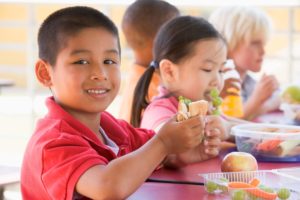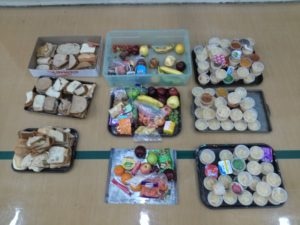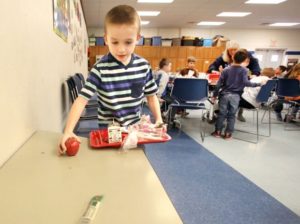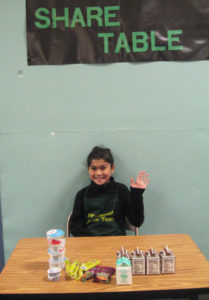Tips/Articles,
Let’s Resolve to Feed Kids: Start a School Food Share
Jan 03 2018

Resolve to Take Action this Year to Combat Hunger and Food Waste at Your School
SCARCE has worked in numerous school cafeterias helping students and faculty get a grasp on their lunchroom waste. It’s a familiar story in almost every school: tons of food is thrown away, with a good portion never having touched students’ lips. At the same time, we hear stories of nurses, teachers, or guidance counselors buying food to feed hungry students.

Trays full of uneaten food found at a school waste audit led by SCARCE.
The food waste is almost entirely going to landfills and contributing to climate change as it rots away. Almost one in seven kids right here in affluent DuPage County is food insecure. The money spent on school food that is thrown away is certainly a waste, and faculty are spending their own hard-earned money to feed their students. Luckily, there’s a simple remedy to all those problems: start a school food sharing program.
School Food Sharing FAQ
What is it?
A food sharing program allows students to place unopened food they will not eat in a designated area (often a table, basket, or cart) where it is then available to any student. This includes unopened milk or juice, whole fruits, and pre-packaged foods such as fruit cups or pretzels and prepared items in packaging. The food is then available for free for any student to take. Schools can also set aside any extra food to use for hungry students throughout the day (with the school nurse or perhaps guidance counselors) or as part of a backpack program for food insecure students to take home.
Is it legal?
Yes! A food sharing program is supported by Illinois and federal laws as well as the United States Department of Agriculture. The main concern is compliance in regards to food safety – it must comply with local health department codes. A summary is listed below.
- IL State Law: Food Donation for Schools & Public Agencies (Act 99-0552) – makes it illegal for food service agencies to prohibit food donation as part of a contract with a school or public agency.
- Federal Law: Emerson Good Samaritan Food Donation Act – protects against liability for food donors
- Forthcoming Federal Law: U.S. Food Donation Act of 2017 – strengthens protections of the Good Samaritan Act
- Federal Support: USDA Food Share Program Memo June 2016 – declares USDA support of food sharing programs, including food subsidized or paid for under the USDA Child Nutrition Programs
- Complementary Federal Goal: USDA & USEPA Food Waste Reduction Goal – aims to reduce US food waste 50% by 2030

A student manning the food sharing table at her school.
How Do I Do It?
Anyone can help get this program running whether you’re a teacher, concerned parent, or school staff. Recruiting allies is important for longevity. Getting school leadership to support the program is very important. You’ll also need buy-in from lunch staff/volunteers. A short training session explaining the why and how to get everyone on the same page is a good start. Then it’s as simple as identifying a location in the lunchroom for food to go during lunch (cart, table, basket), a location for the extra food after lunch is over, and picking a start date. Make sure to announce to students the new Food Share program and how it works. Signage is key for identifying the location and types of items that can be shared. Some schools have students from the eco-club help lead the initiative. It would be a good idea to have someone act as a Food Share program advocate in the lunchroom the first few days or weeks.
What does it cost?
Not a thing! The food is already paid for since it was either brought from home or purchased by a student. Odds are, you can find the supplies to make signs already at school (if not, and you’re in the Chicago area, stop by our Book Rescue). It hardly takes any extra work by lunchroom staff, especially if students from a volunteer, leadership, or eco-club get involved. Odds are a cart, basket or space on a table already exist. There will also be less garbage so perhaps your school can even save on disposal costs. What are you waiting for?
Resolve to feed kids this year and before you know it, you’ll be filling bellies instead of trash cans without spending a dime.